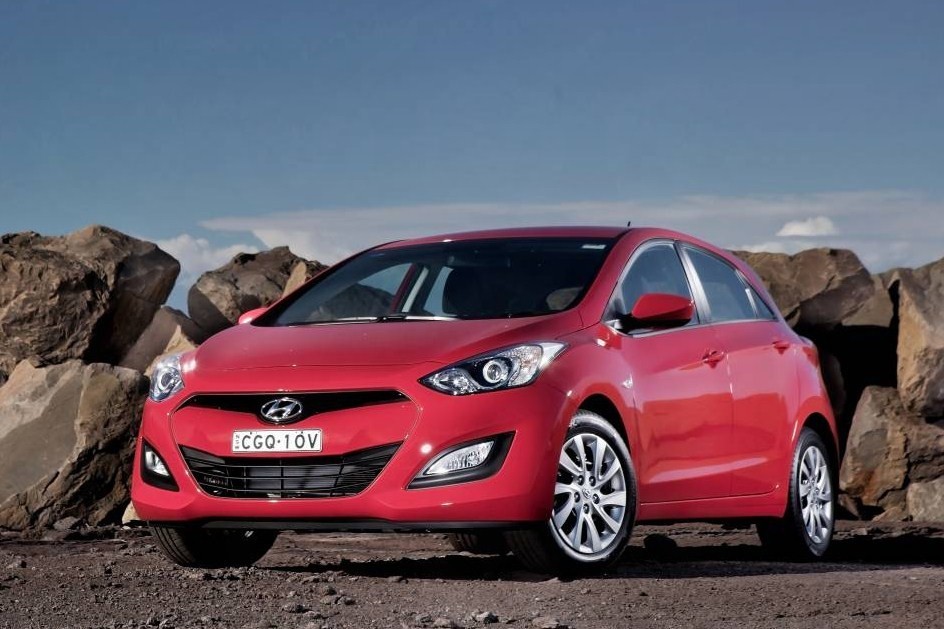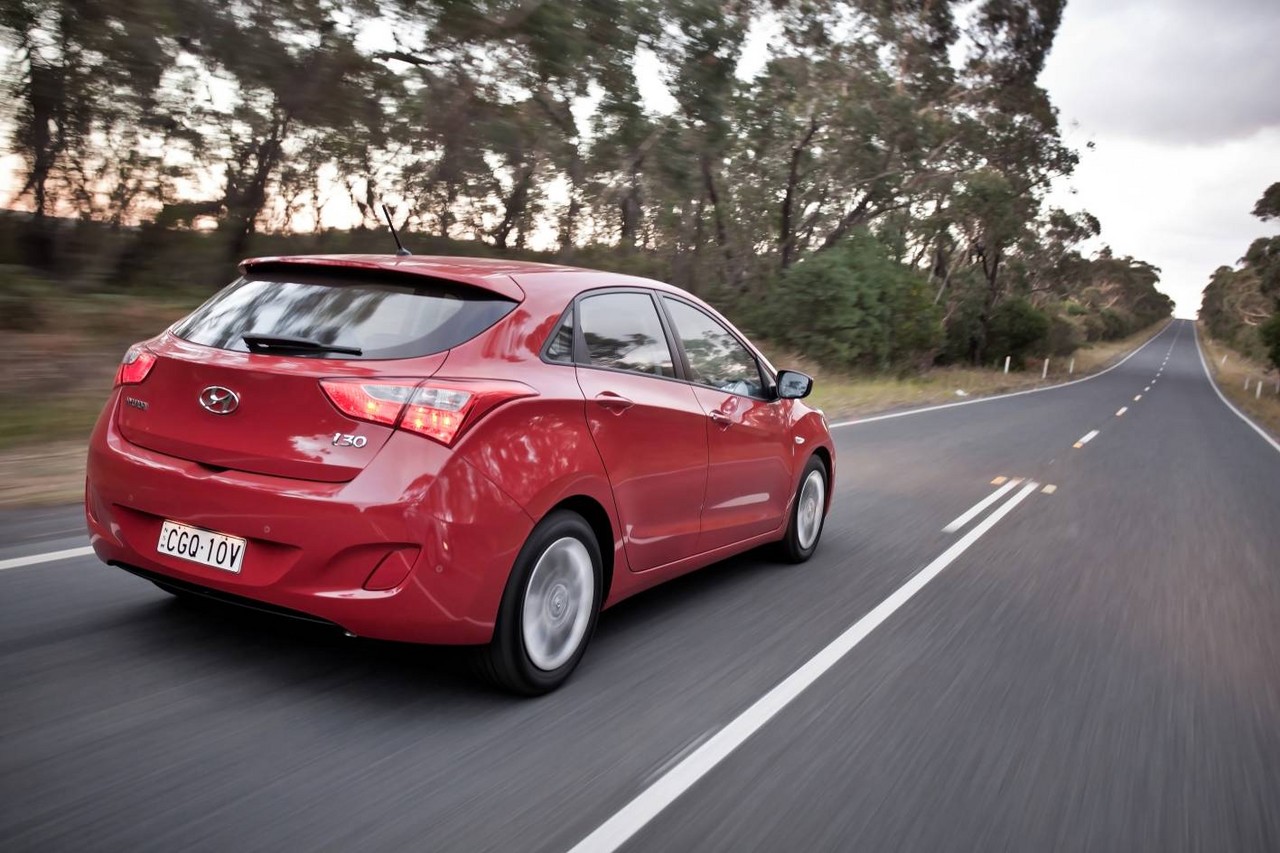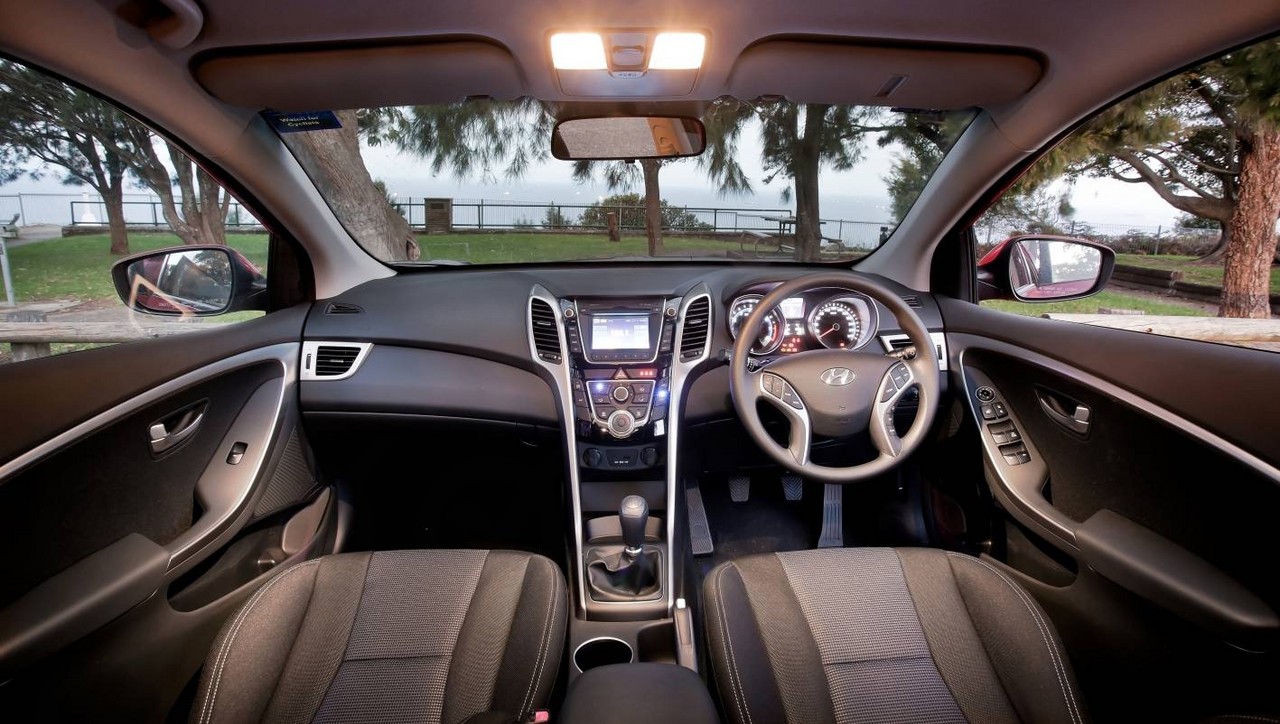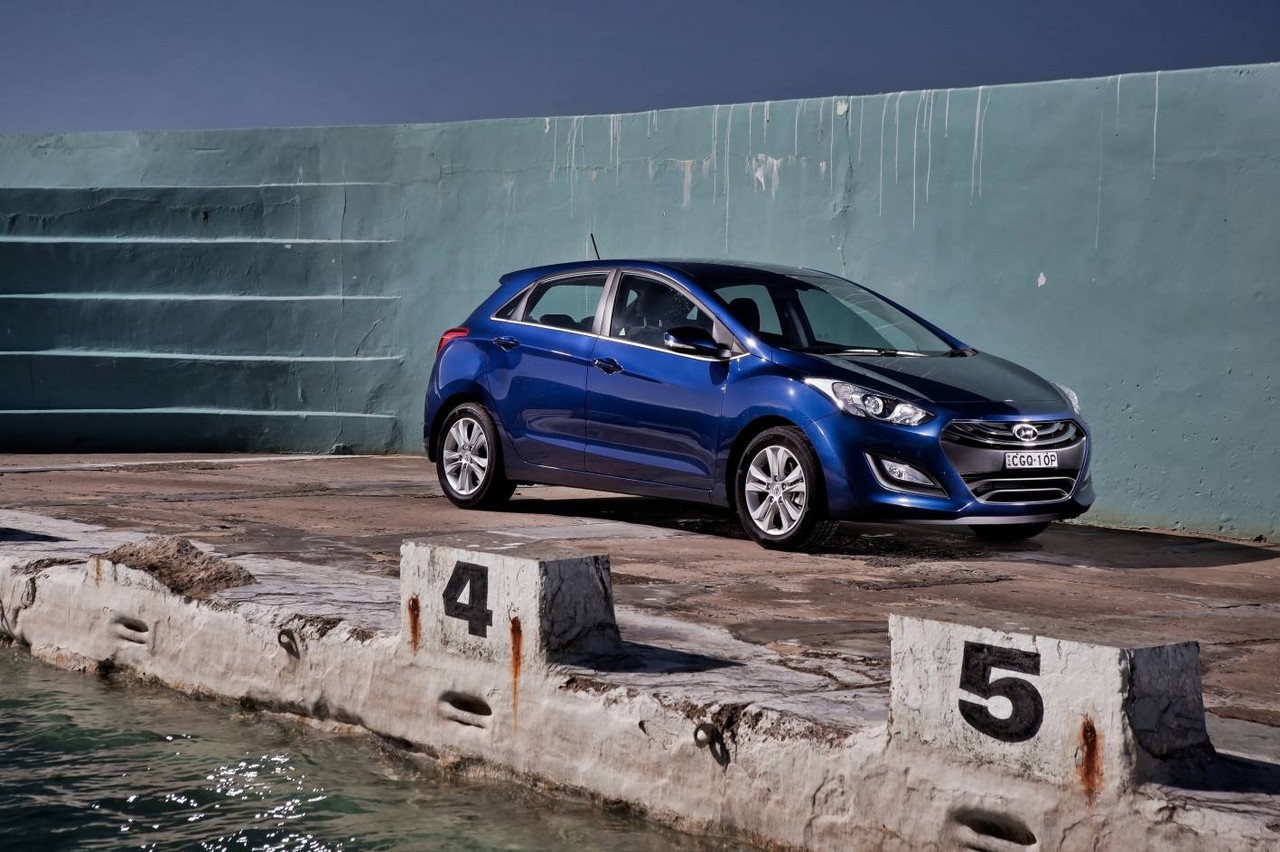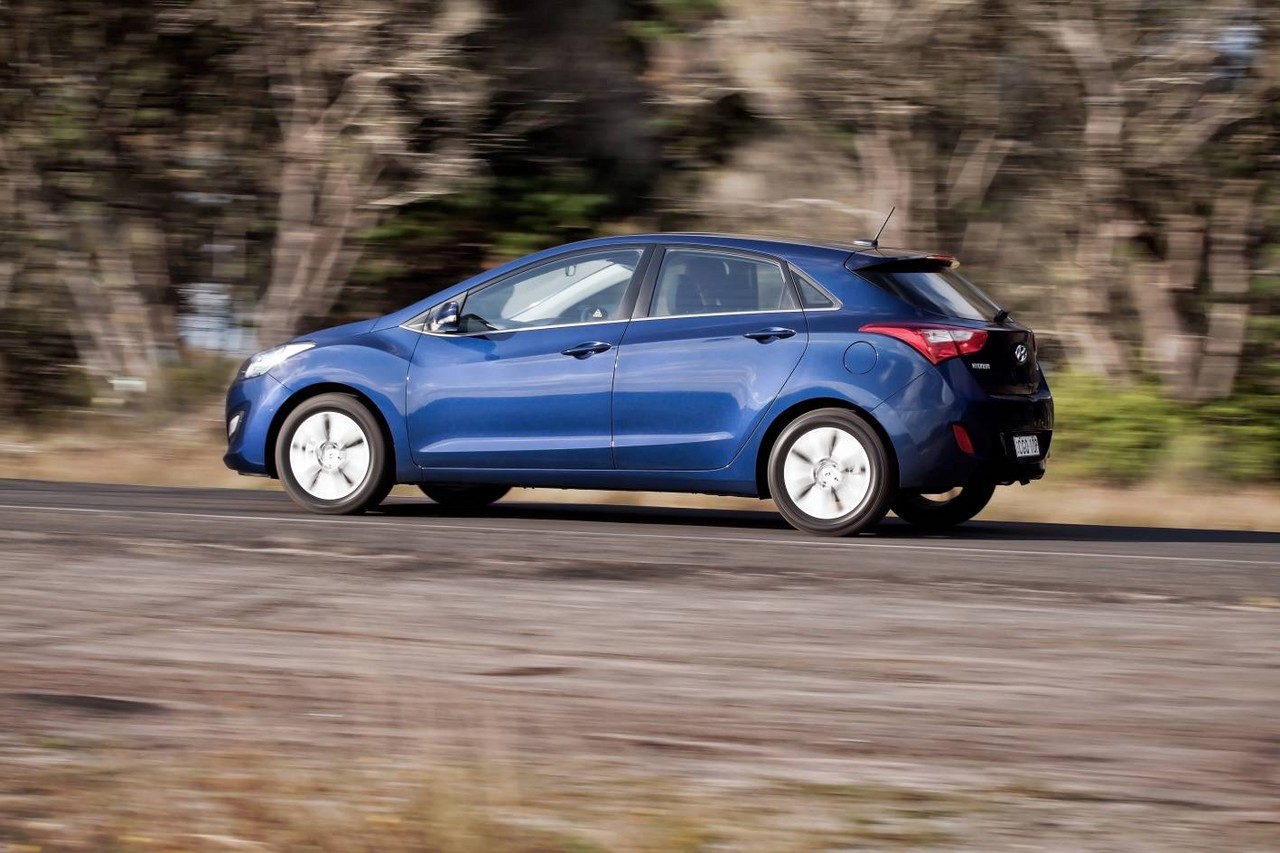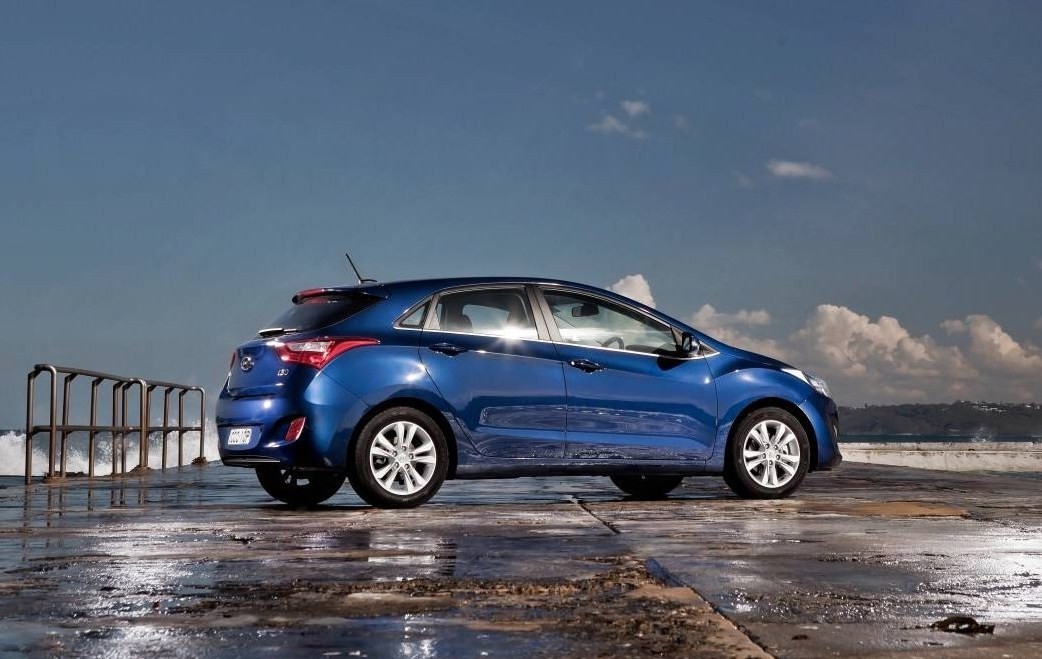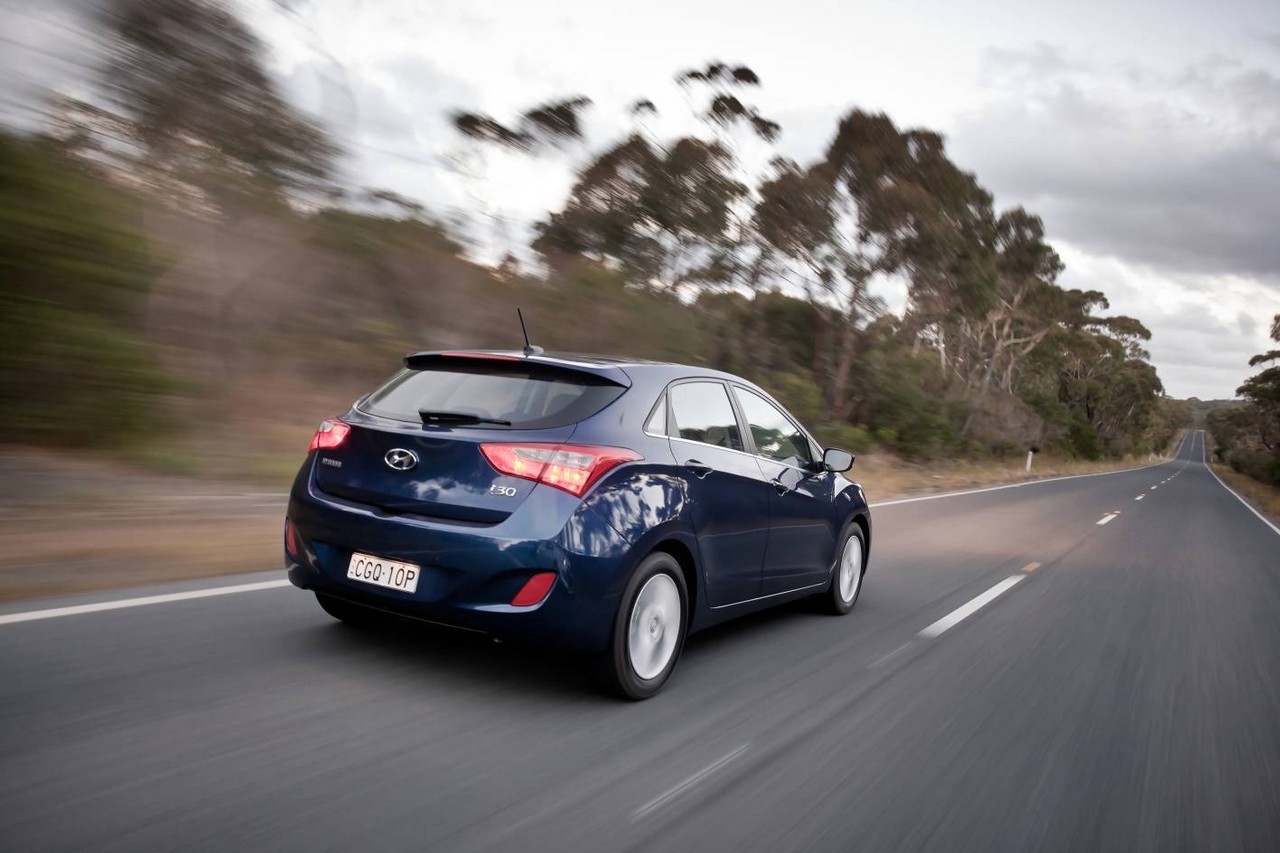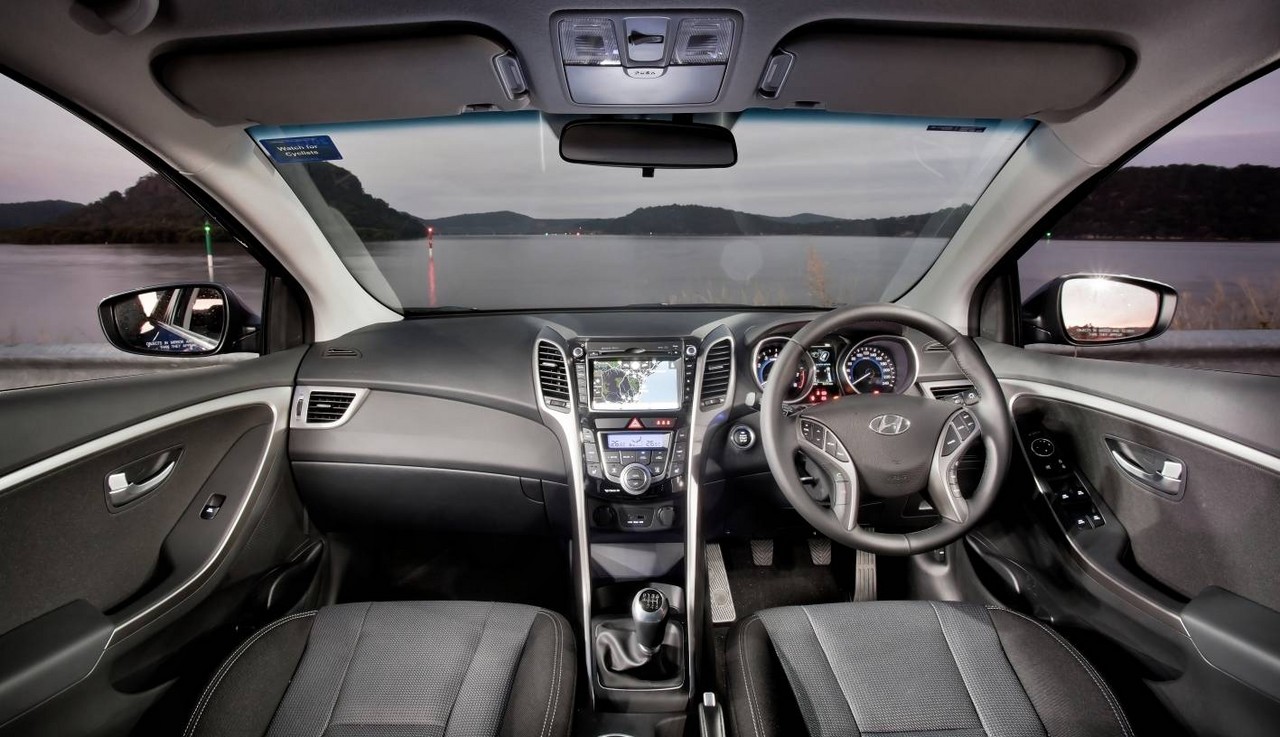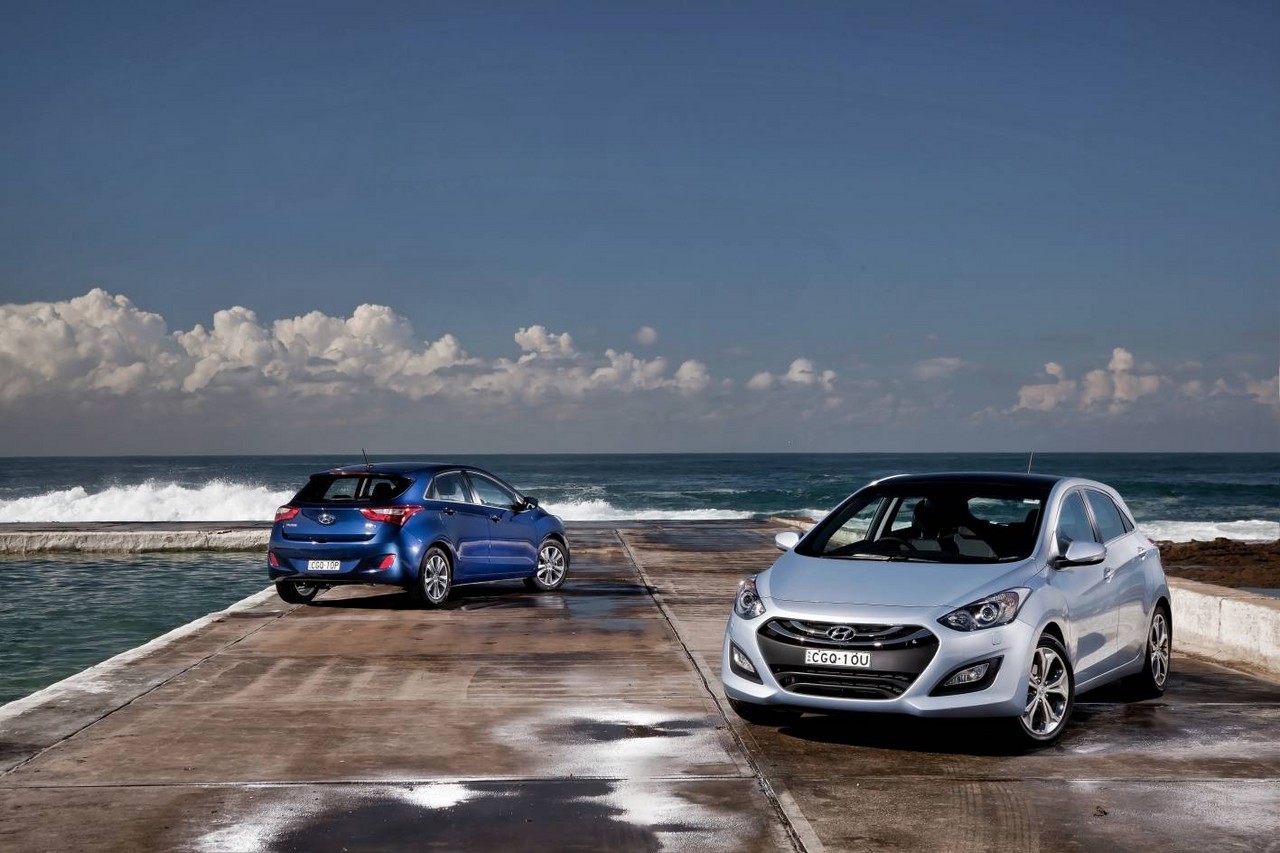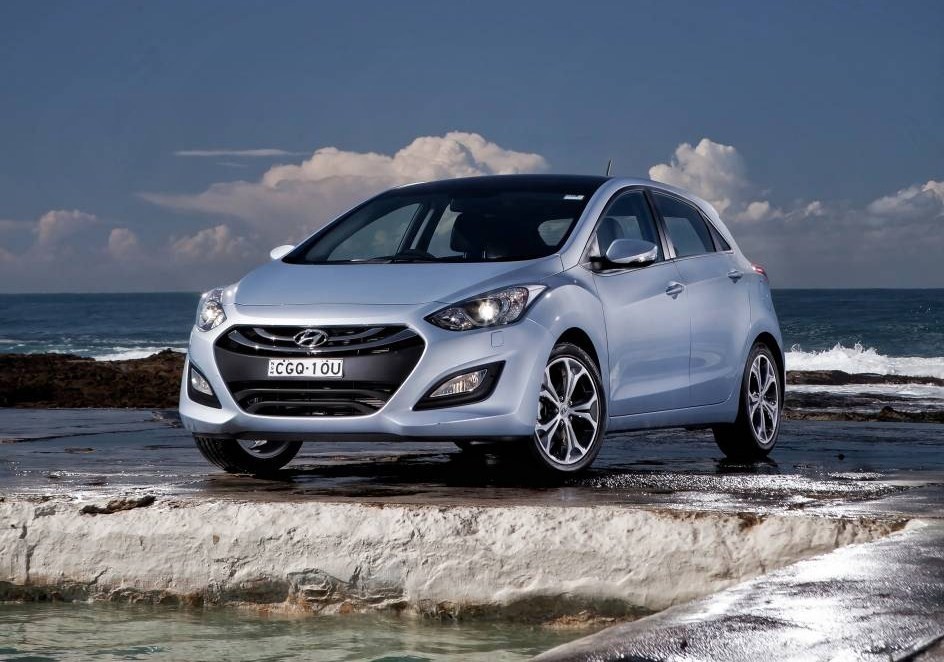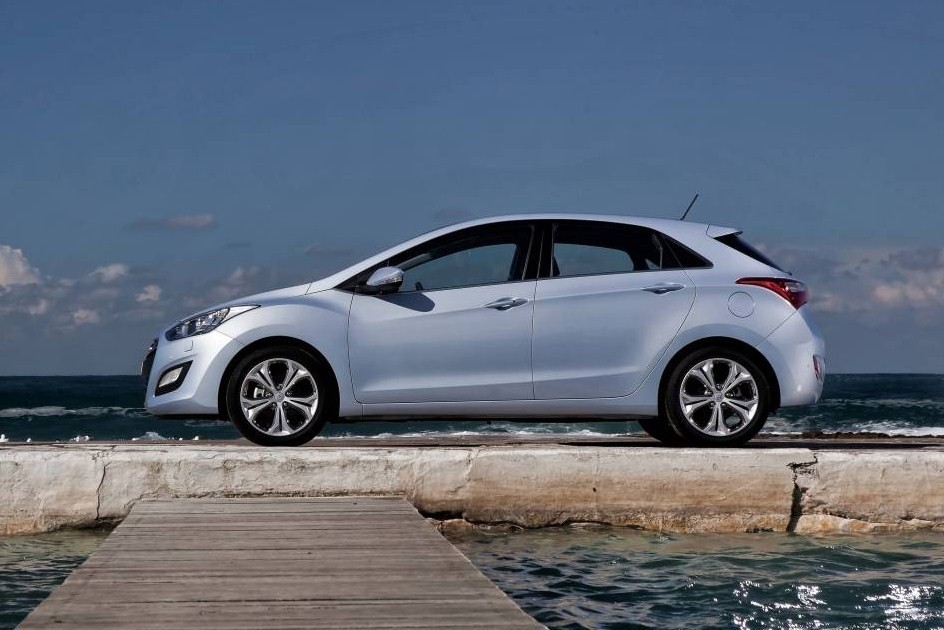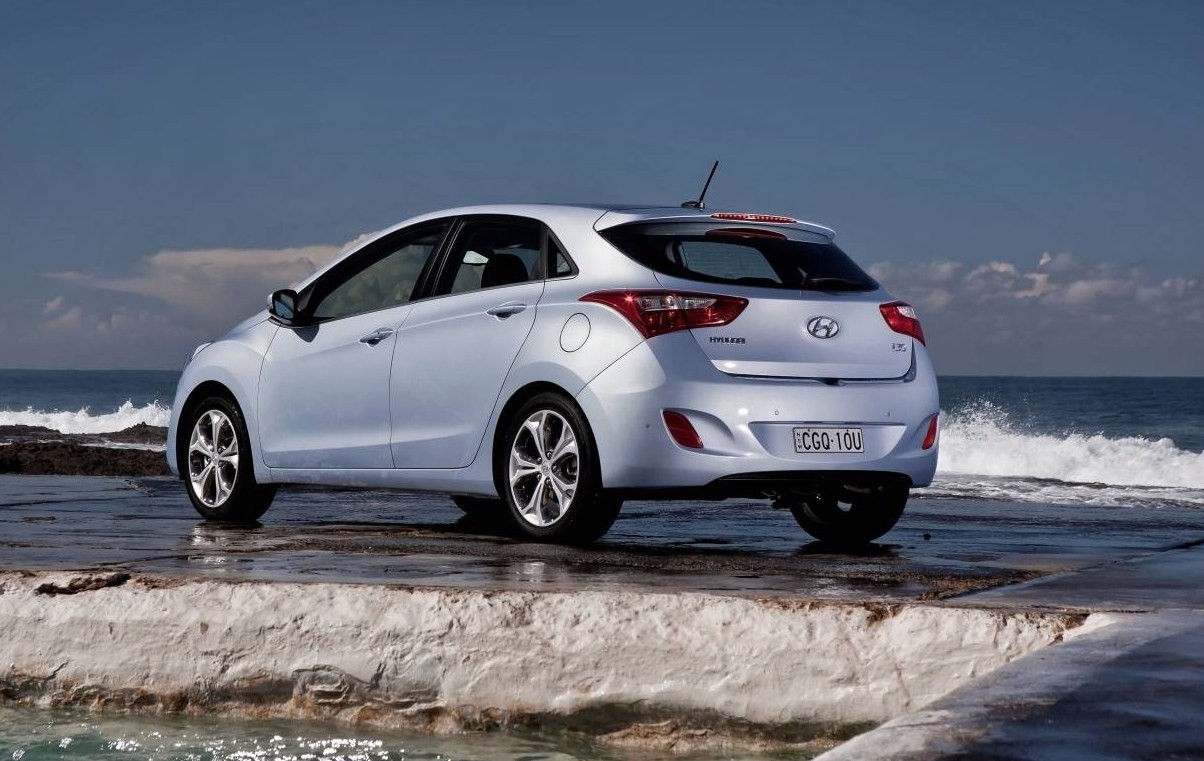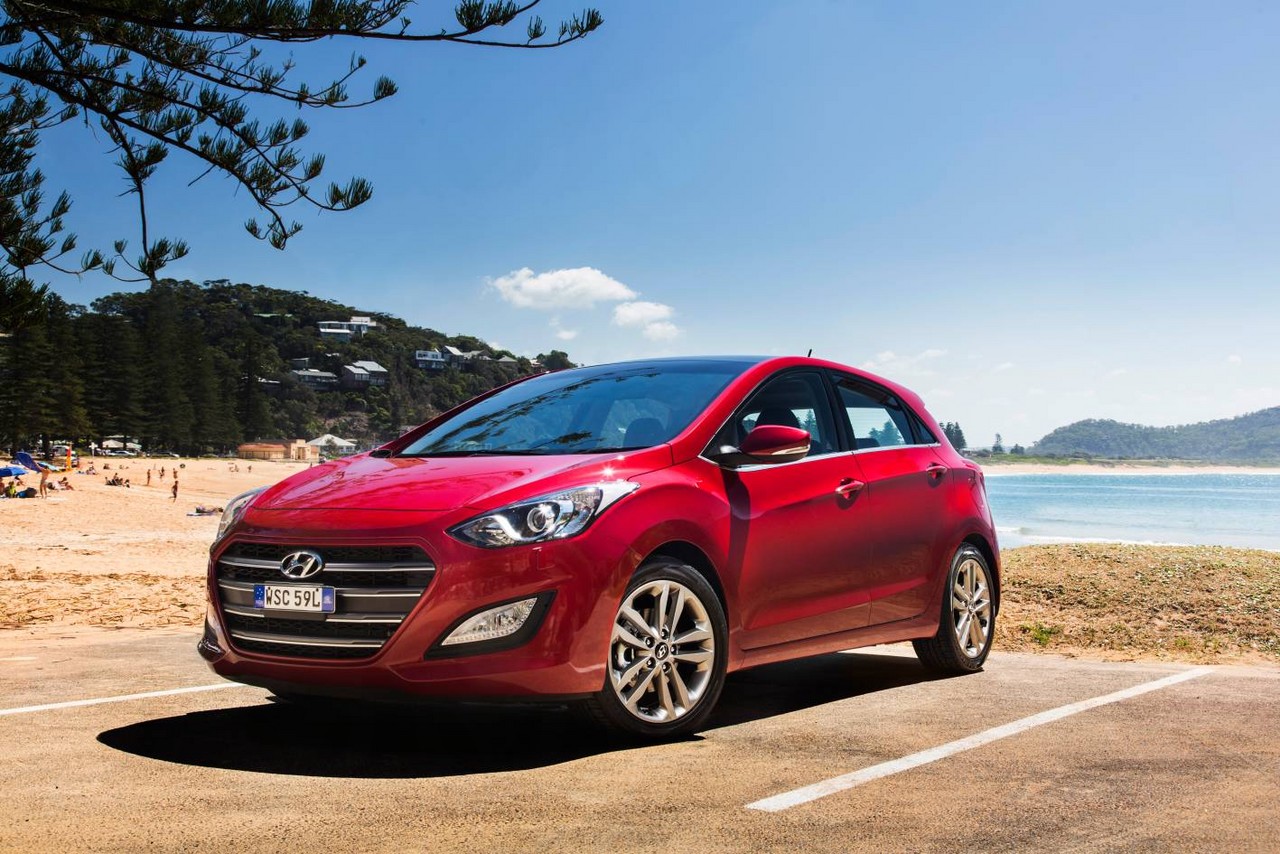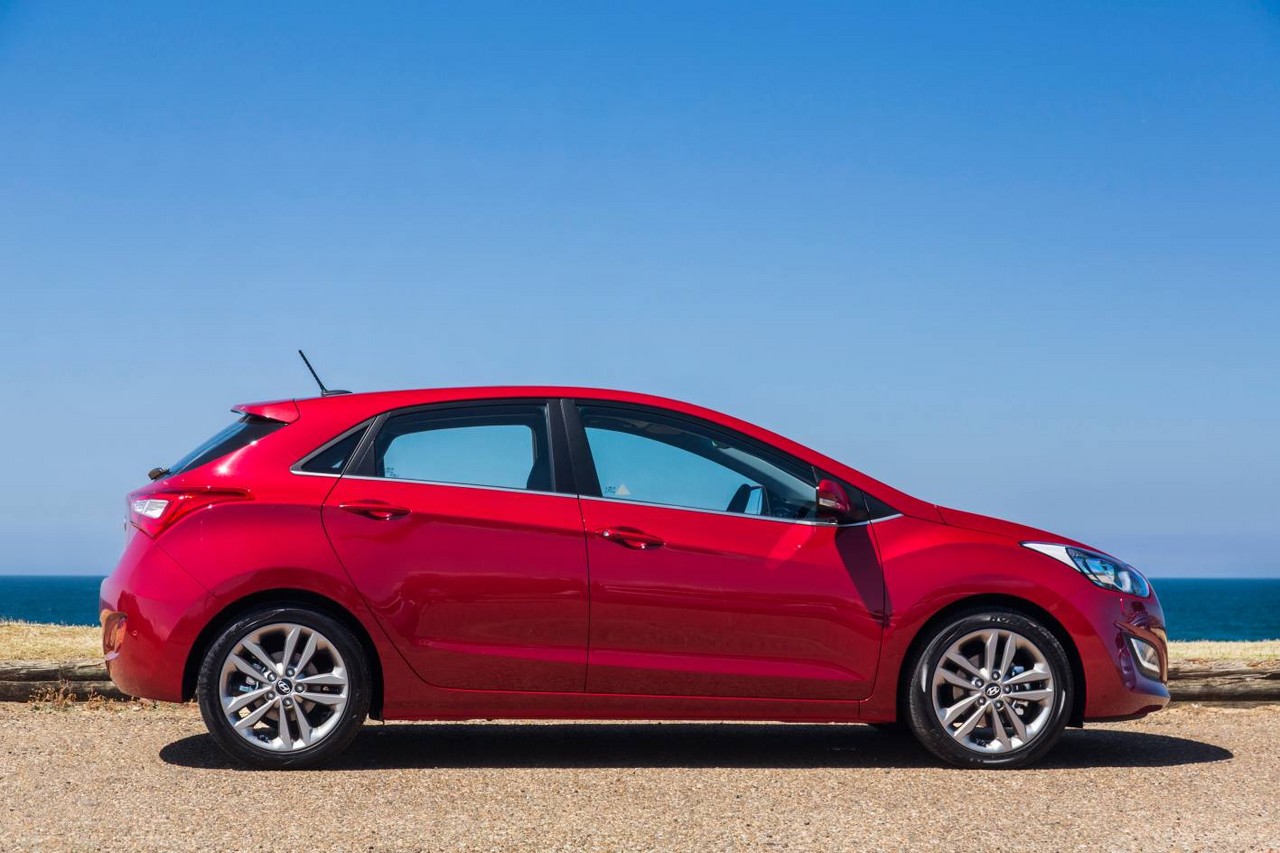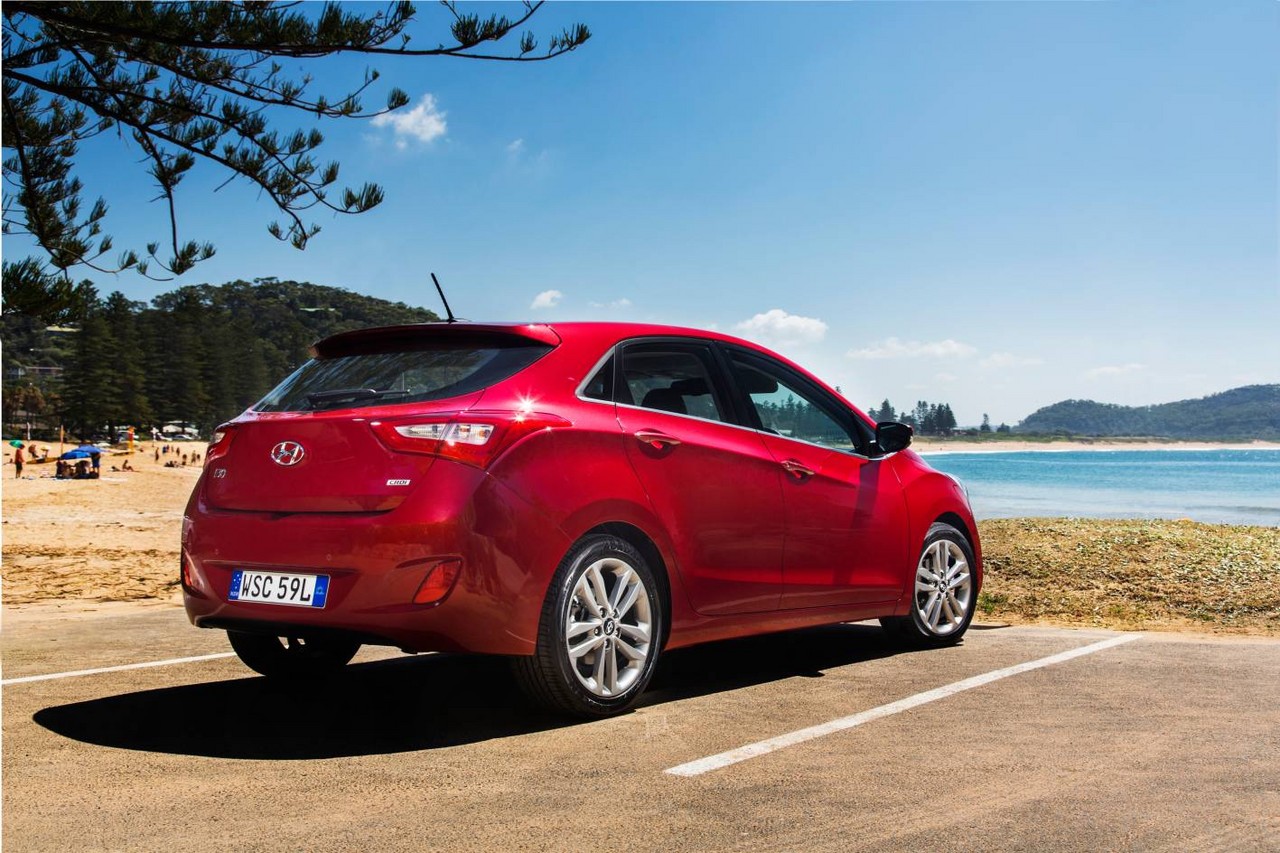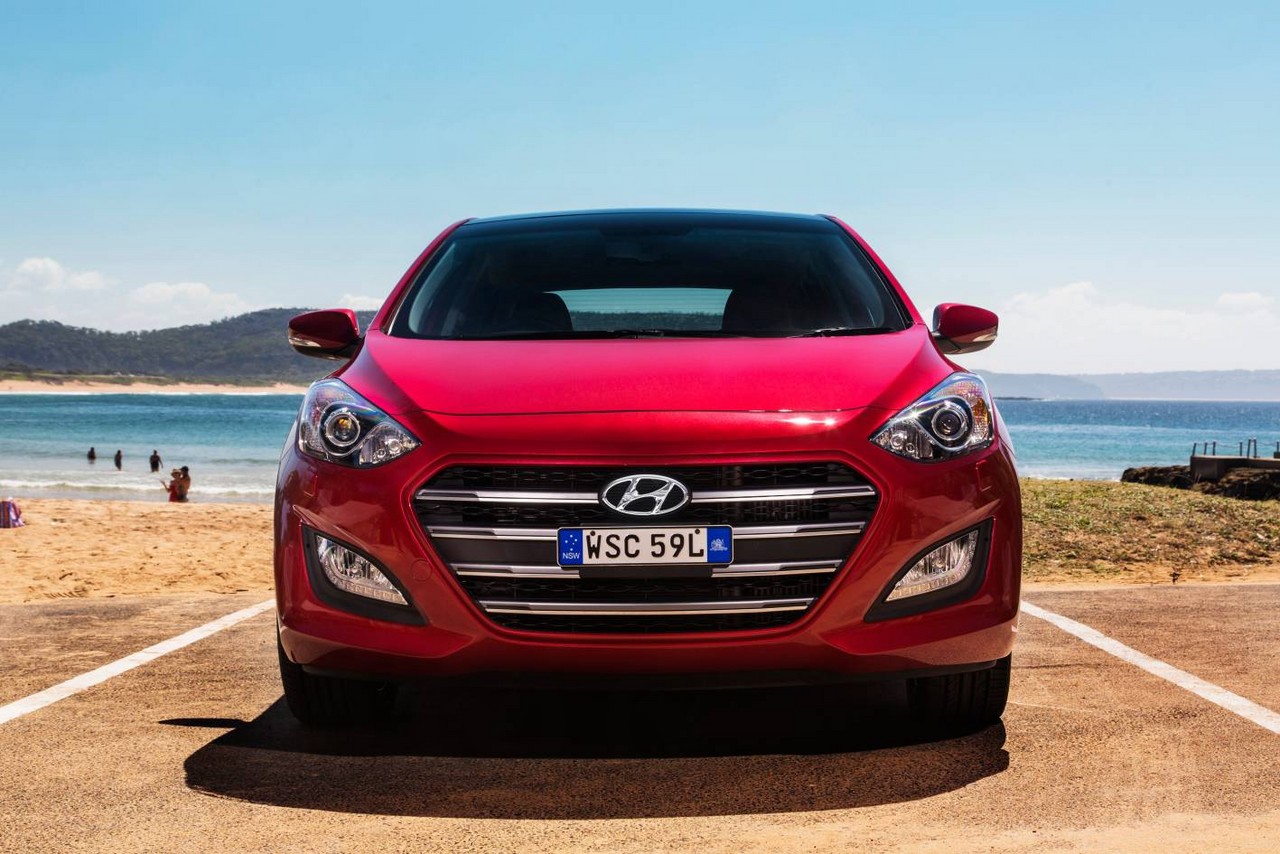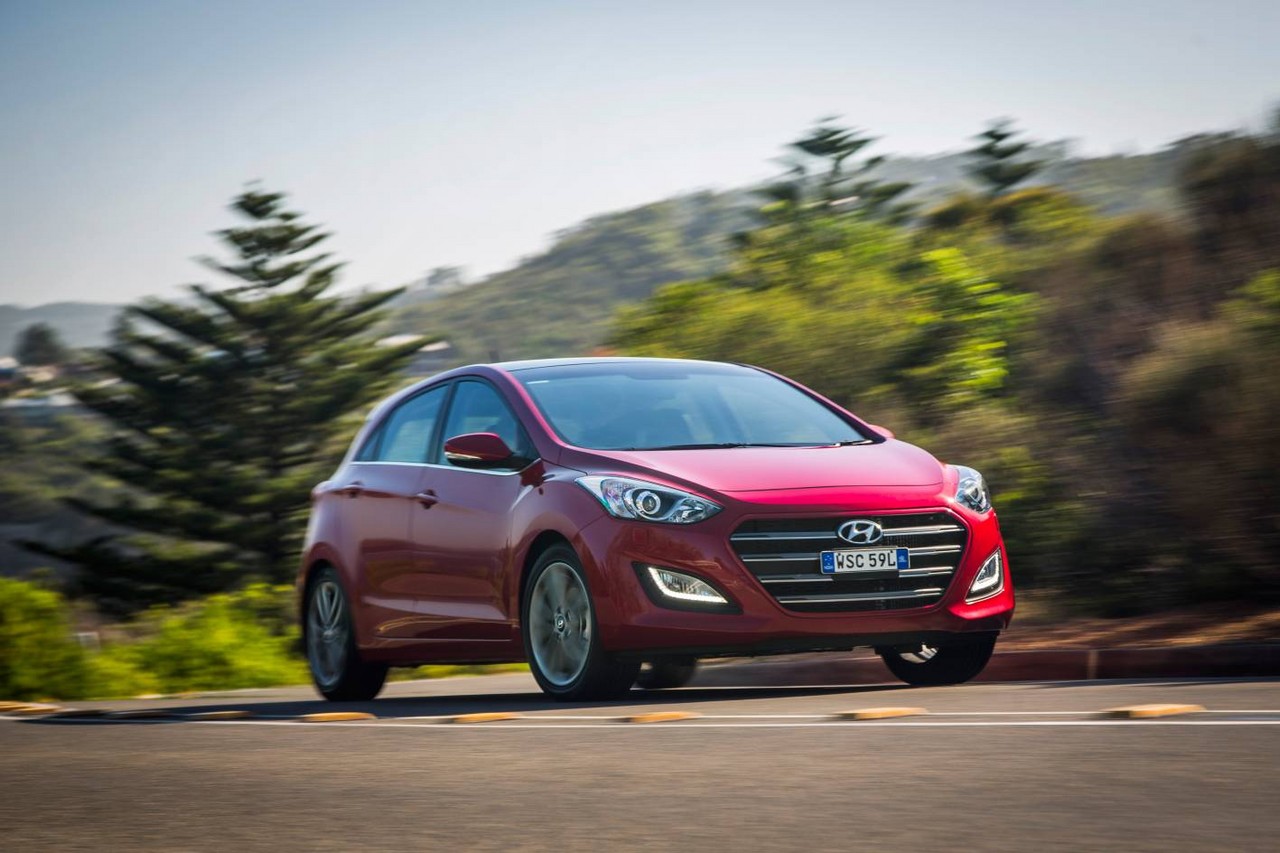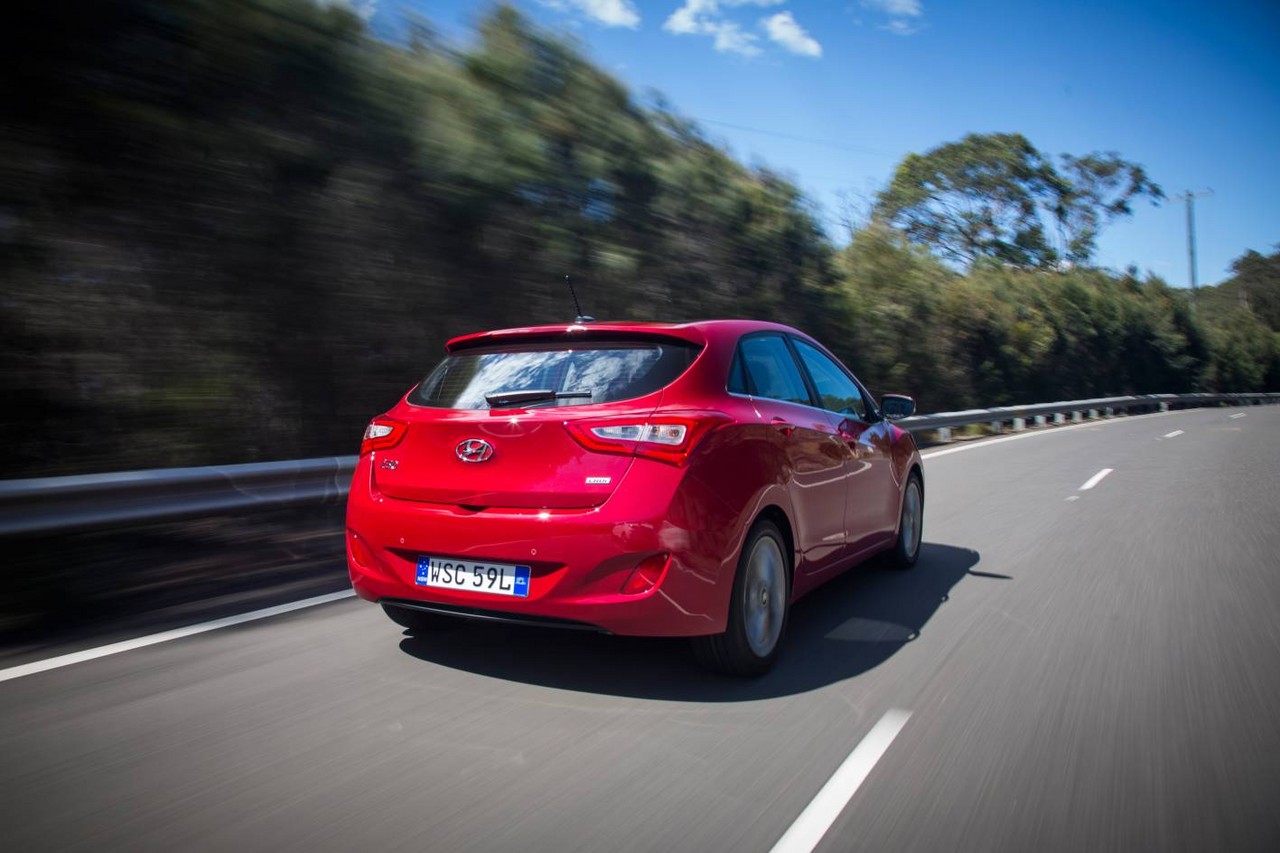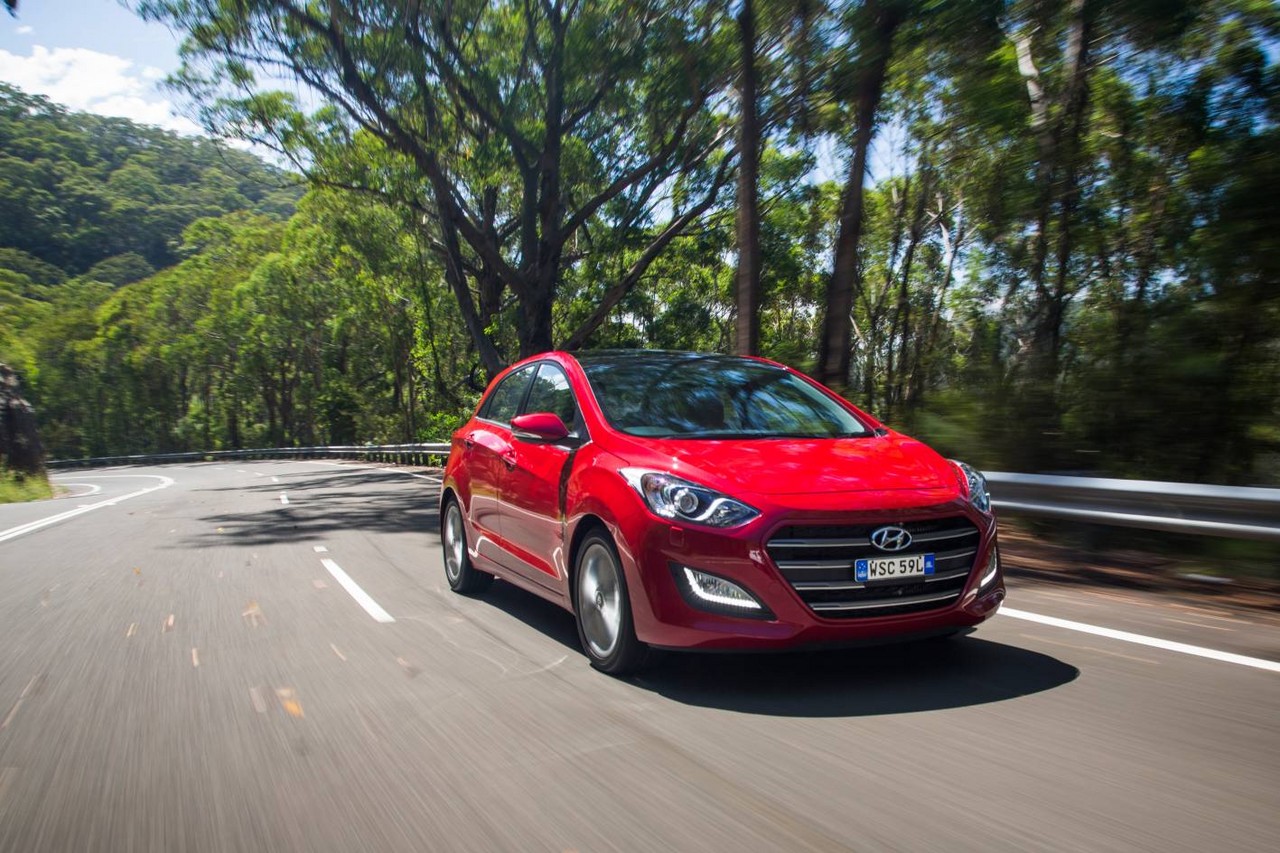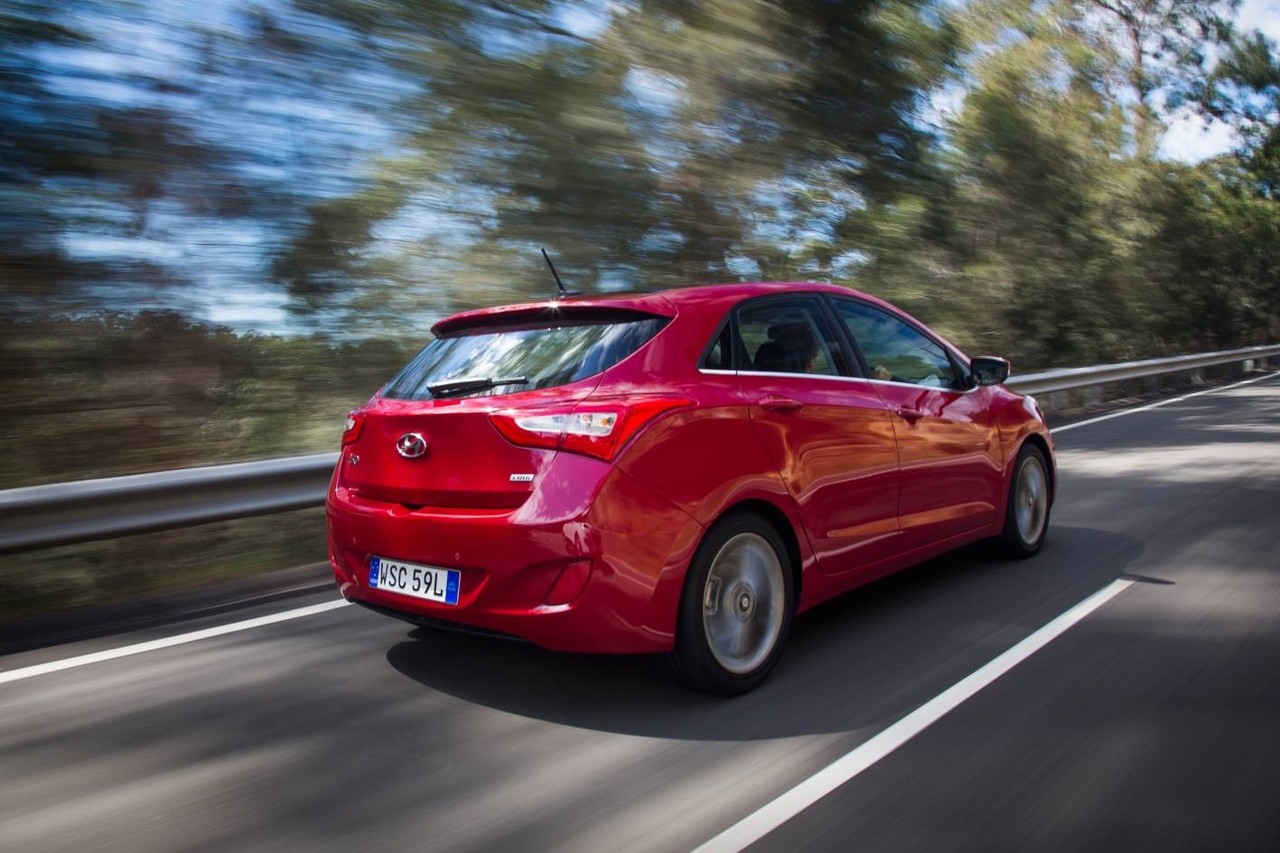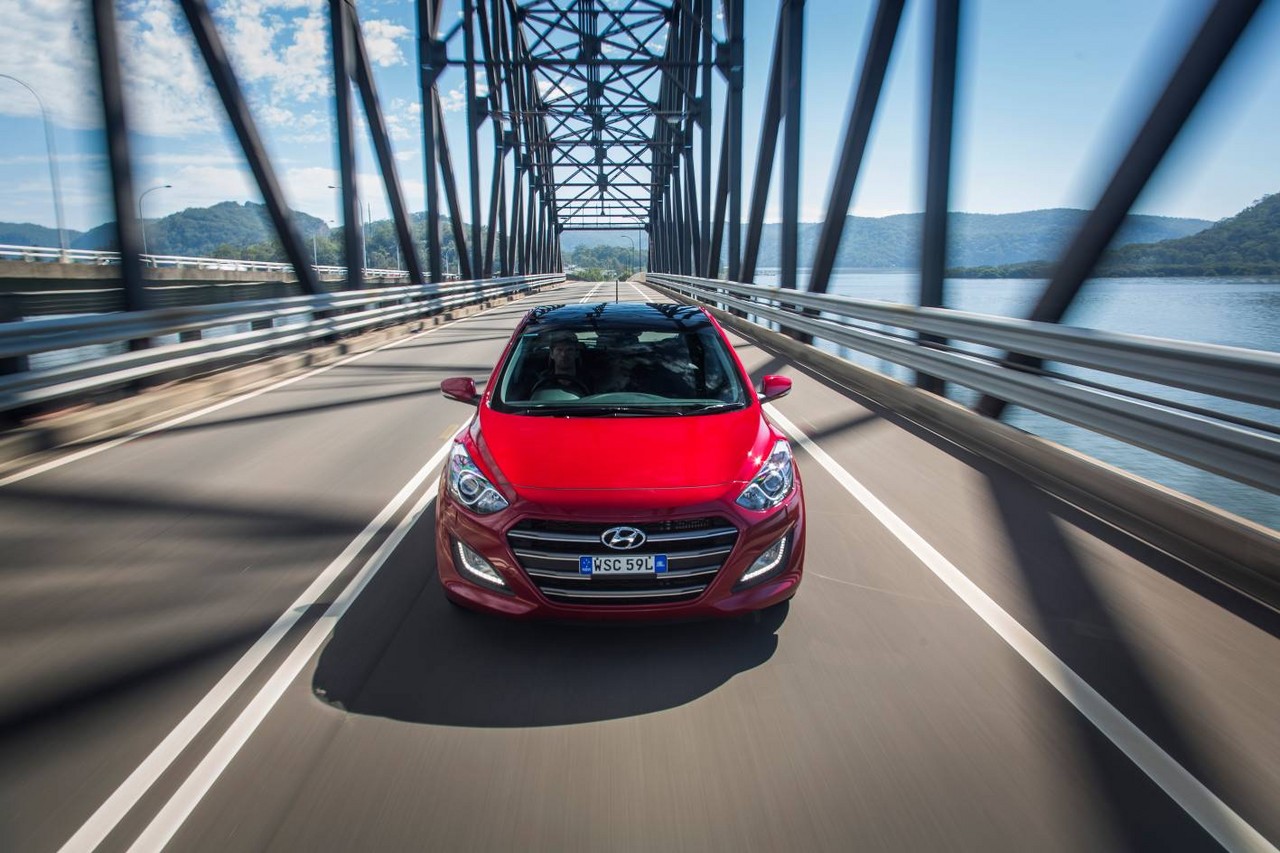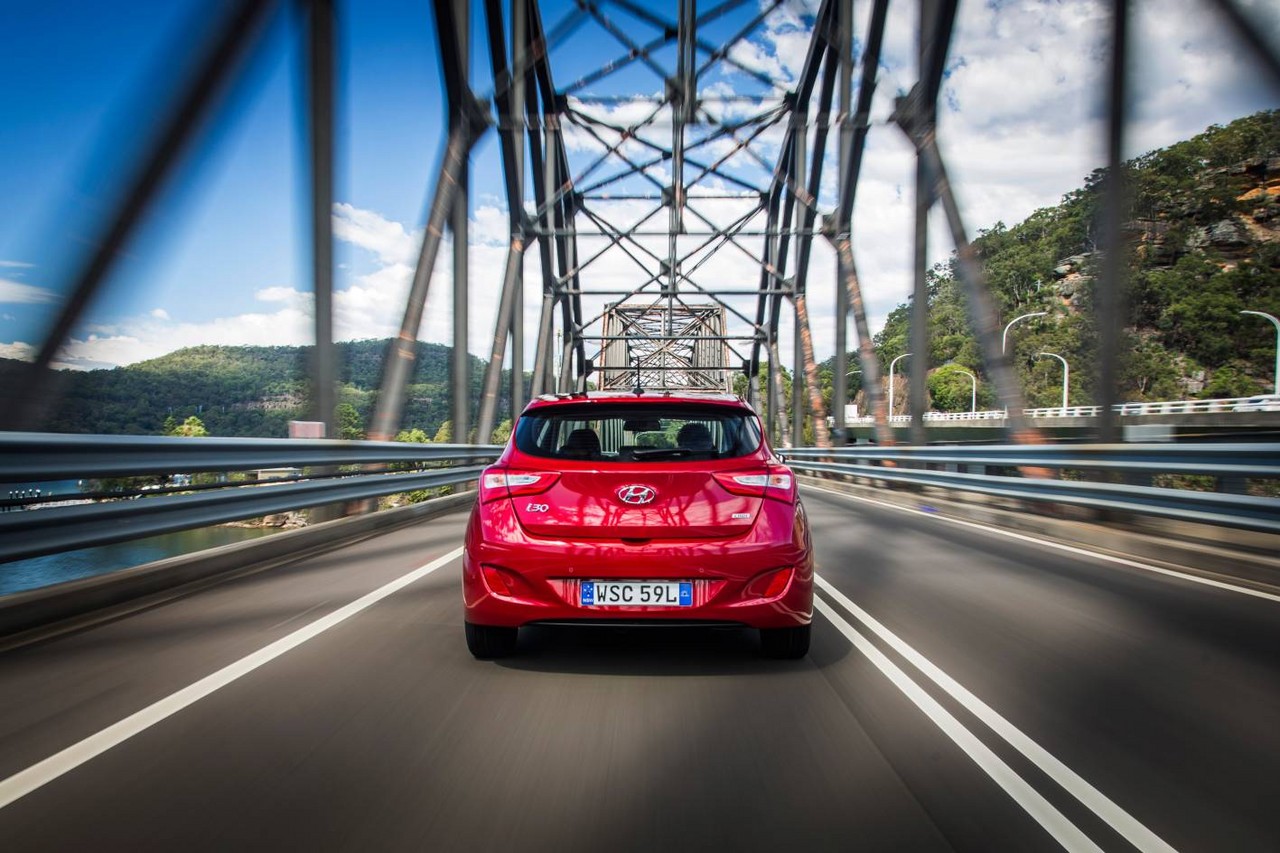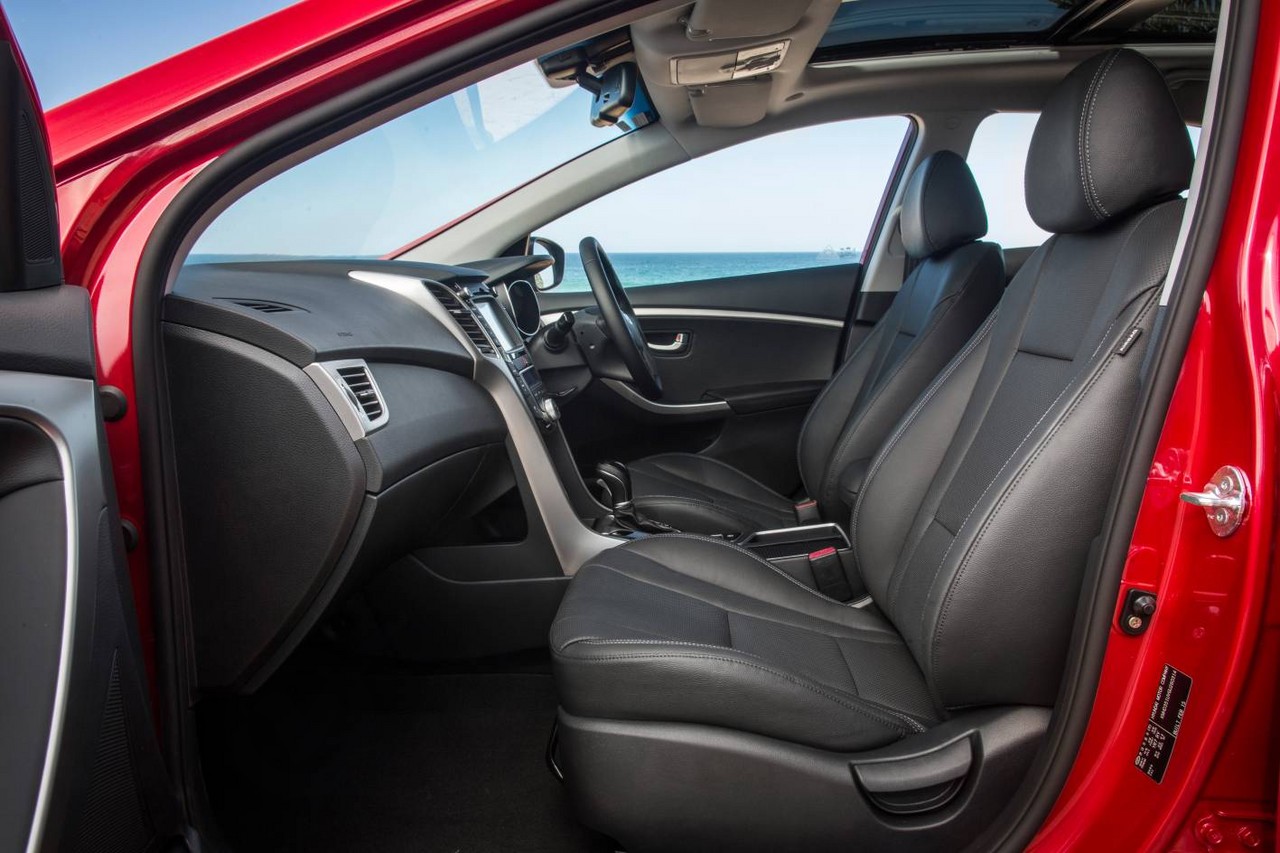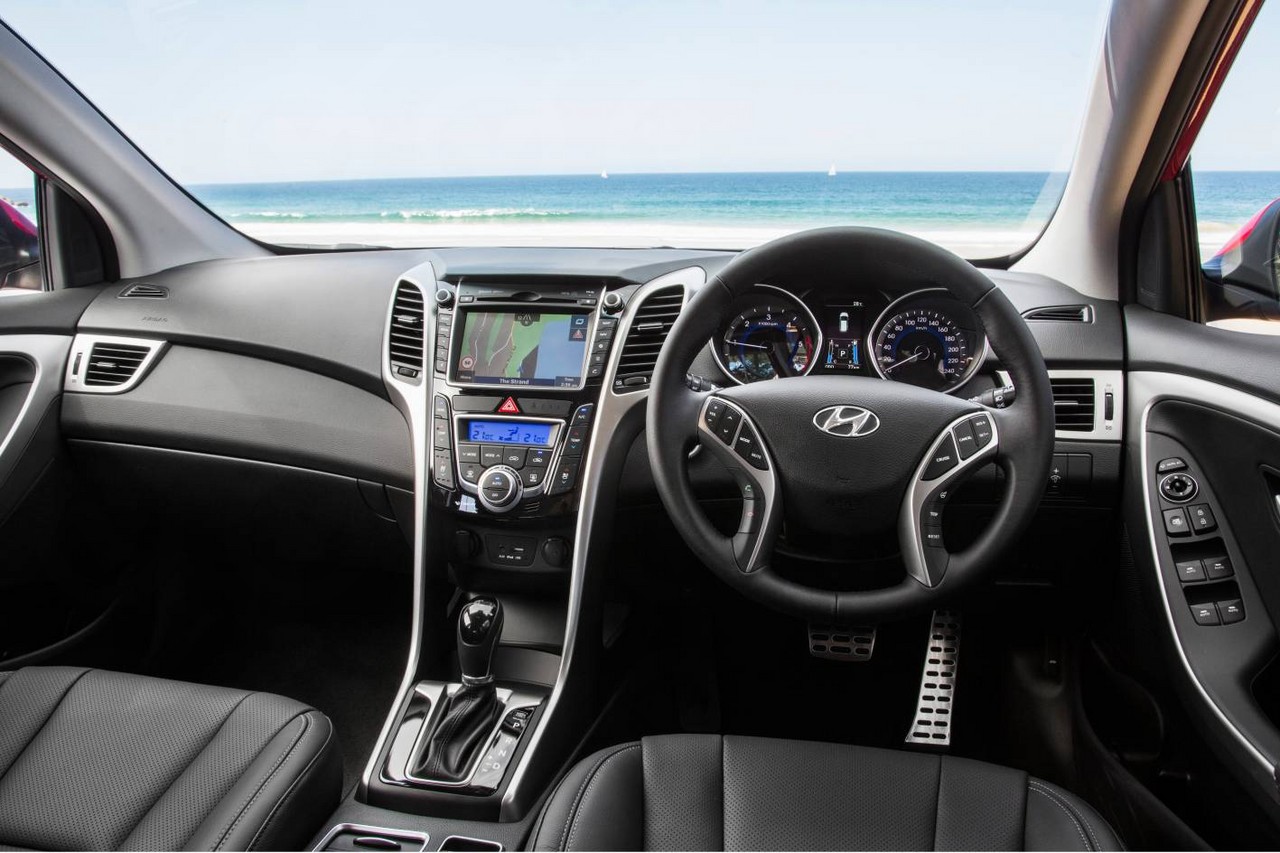
- Comfortable ride
- High standard of interior fit and finish
- Quiet, well-insulated cabin
- Frugal turbo-diesel engine
- Vague steering
- Interior lacks sound insulation
- Dynamics fall short of Ford Mk.3 Focus and Mazda BL Mazda3
Review: Hyundai GD.I i30 (2012-15)
Overview
Released in July 2012, the Hyundai GD Series I (GD.I) i30 was initially available as a small, five-door hatchback. Three-door models, however, were subsequently introduced with Special Editions (July 2013) and SR editions (August 2013). Manufactured in Ulsan, South Korea, the front-wheel drive Hyundai GD i30 was available with three petrol engines (the 1.6 GDI, 1.8 MPI and 2.0 GDI) and one turbo-diesel engine (1.6 CRDi).
G4NB, G4FD, G4NC and D4FB engines
Of the engines,
- the 1.8-litre G4NB ‘Nu’ petrol engine had an aluminium cylinder block and head, multi-point fuel injection, double overhead camshafts, four valves per cylinder, continuously variable intake and exhaust valve timing (D-CVVT) and a compression ratio of 10.3:1;
- Reserved for the Special Editions, the 1.6-litre G4FD ‘Gamma’ petrol engine which had an aluminium block and cylinder head, direct fuel injection, double overhead camshafts, four valves per cylinder, continuously variable intake and exhaust valve timing (D-CVVT) and a compression ratio of 11.0:1;
- For the SR editions, the 2.0-litre G4NC ‘Nu GDI’ differed in that it had a variable induction system and a compression ratio of 11.5:1; and,
- The 1.6-litre D4FB ‘U’ diesel engine had a cast iron engine block, an aluminium cylinder head, common-rail injection, a variable geometry turbocharger, double overhead camshafts, four valves per cylinder and a compression ratio of 17.3:1.
All engines were available with six-speed manual or automatic transmissions. While manual models had a gearshift indicator light to encourage fuel-efficient driving, automatic models had an ‘ECO indicator’ with fuel conservation tips.
| Variant | Engine | Edition | Years | Trans. | Peak power | Peak torque |
|---|---|---|---|---|---|---|
| 1.6 GDI | 1.6-litre petrol I4 | Special Edition | 2013 | 6sp man., 6sp auto |
98 kW at 6300 rpm | 163 Nm at 4850 rpm |
| 1.8 MPI | 1.8-litre petrol I4 | Active, Elite |
2012-15 | 6sp man., 6sp auto |
110 kW at 6500 rpm | 178 Nm at 4700 rpm |
| Trophy | 2014 | |||||
| Premium | 2012-15 | 6sp auto | ||||
| 2.0 GDI | 2.0-litre petrol I4 | SR | 2013-15 | 6sp man., 6sp auto |
129 kW at 6500 rpm | 209 Nm at 4700 rpm |
| 1.6 CRDi | 1.6-litre turbo-diesel I4 | Active, Elite |
2012-15 | 6sp man., 6sp auto |
94 kW at 4000 rpm | 260 Nm at 1900-2750 rpm |
| Trophy | 2014 | |||||
| Premium | 2012-15 | 6sp auto |
Dimensions
Compared to the Hyundai FD i30 which it replaced, the GD i30 was 55 mm longer (at 4300 mm), 5 mm wider (1780 mm) and 10 mm lower (1470 mm), though wheelbase length was unchanged (2600 mm). Furthermore, cargo capacity increased by 10 per cent (with the rear seats upright).
Suspension and steering
The Hyundai GD i30 had MacPherson strut front suspension and a torsion beam rear axle with Sachs dampers front and rear; the suspension was also tuned for Australian conditions; an exception, however, was the three-door i30 SE which had multi-link rear suspension.
The Hyundai GD i30 had a speed-sensitive electric power-assisted steering system with three selectable settings: Normal, Comfort and Sport.
Safety equipment
Standard safety equipment for the Hyundai GD i30 included dual front airbags, a driver’s knee airbag, front side airbags, full-length curtain airbags, ABS, electronic brake force distribution, brake assist, electronic stability control, traction control and front seatbelts with pretensioners and load limiters.
Brakes
The Hyundai GD i30 had 280 mm by 23 mm ventilated front brake discs and 262 mm by 10 mm solid rear discs.
Euro NCAP testing
In Euro NCAP testing , a 2012 Hyundai GD i30 that was fitted with a 1.4-litre engine received a five star safety rating which included a 90 per cent adult occupant protection rating and a 90 per cent child occupant protection rating. In the offset impact, occupant protection was generally rated as good, though protection of the chest and left lower leg were rated as adequate. In the side impact test, occupant protection was also generally rated as good, though chest protection was adequate. In the more severe pole test, chest protection was rated as weak and abdominal protection as adequate. Under ANCAP’s assessment regime , this testing resulted in a five star adult occupant protection rating with a score of 35.69 out of 37.
Features: Hyundai i30 Active
Standard features for the Hyundai i30 Active included a six speaker sound system with a five-inch touch screen, CD player, MP3-compatibility and auxiliary inputs (3.5 mm/USB/iPod), Bluetooth connectivity and audio streaming, air conditioning, cruise control, front fog lights, rear parking sensors, 60/40 split and folding rear seats, steering wheel audio and cruise controls, remote central locking, power windows and heated mirrors, tilt and telescopic steering wheel adjustment, a height adjustable driver’s seat, three 12 volt power outlets, a temporary spare wheel and an immobiliser.
Features: Hyundai i30 Elite
Compared to the Hyundai i30 Active, the i30 Elite was further equipped with 16-inch alloy wheels, satellite navigation system with SUNA live traffic updates and a seven-inch touch screen, dual-zone climate control air conditioning, a rear view camera, automatic headlights, rain-sensing wipers, proximity key, power folding mirrors and a full size spare wheel.
Features: Hyundai i30 Premium
The range-topping Hyundai i30 Premium was distinguished by its 17-inch alloy wheels, leather/’leatherette’ seats, a power adjustable driver’s seat, heated front seats, xenon headlights with washers, flat folding rear seats, a panoramic glass sunroof, power-operated park brake, electrochromatic rear view mirror and an under-floor storage compartment.
2013 Hyundai i30 SR
Released in August 2013, the sports-oriented Hyundai i30 SR had a unique suspension tune that was developed for Australia and included stiffer front springs. Visually, the SR could be identified by its 17-inch machined-face alloy wheels, sports front grille with piano-black insert, rear diffuser and ‘SR’ badges.
Compared to the Elite editions, the SR was further equipped with leather/leatherette upholstery, a power adjustable driver’s seat, xenon headlights, LED rear combination lights, alloy-faced pedals and an electrochromatic rear view mirror. A panoramic glass sunroof was also available as an extra-cost option.
2013 Hyundai i30 Special Edition (SE)
Released in July 2013, the Hyundai i30 1.6 GDI Special Edition had similar features to the Active editions but was distinguished by its 16-inch twin-spoke alloy wheels, dark chrome front grille and revised rear fascia (with horizontal fog lights and a black insert at the base of the bumper).
The i30 Special Edition returned in September 2014, but was offered with the 1.8 MPI and 1.6 CRDI engines. Compared to the i30 Active, the 2014 i30 Special Edition added 16-inch alloy wheels, leather appointed seats, premium door trim, a premium steering wheel and gear knob, and power folding door mirrors with LED indicators.
2014 Hyundai i30 Trophy
Released in January 2014, the Hyundai i30 Trophy edition was based on the entry-level Active edition but further equipped with 16-inch five double-spoke alloy wheels, leather seat trim, power folding door mirrors with LED indicators and a premium steering wheel and gearshift lever.
Brochures
Specifications
Related links
- Press release: Hyundai GD i30 (May 2012)
- Press release: Hyundai GD i30 3-Door Special Edition (July 2013)
- Press release: Hyundai GD i30 SR (August 2013)
- Press release: Hyundai GD i30 Trophy (January 2014)
Review: Hyundai GD.II i30 (2015-16)
Overview
Released in Australia in April 2015, the Hyundai GD Series II (GD.II) i30 introduced a revised range which consisted of Active, ActiveX, SR, SR Premium and Premium editions (see table below). Visually, the GD.II i30 could be identified by its hexagonal front grille and new designs for the wheel covers and alloy wheels.
While the Nu engines were carried over for the 1.8 MPI and 2.0 GDI variants, the 1.6 CRDi variants were powered by Hyundai’s ‘U-II’ turbo-diesel engine which had a lower compression ratio of 16.0:1. The U-II turbo-diesel engines were available with six-speed manual and newly introduced seven-speed double clutch transmissions which had a twin-plate dry clutch design.
| Variant | Engine | Edition | Trans. | Peak power | Peak torque |
|---|---|---|---|---|---|
| 1.8 MPI | 1.8-litre petrol I4 | Active, ActiveX |
6sp man., 6sp auto |
107 kW at 6500 rpm | 175 Nm at 4700 rpm |
| 2.0 GDI | 2.0-litre petrol I4 | SR, SR Premium |
6sp man., 6sp auto |
124 kW at 6500 rpm | 201 Nm at 4700 rpm |
| 1.6 CRDi | 1.6-litre turbo-diesel I4 | Active, ActiveX |
6sp man. | 100 kW at 4000 rpm | 260 Nm at 1500-3500 rpm |
| Active, ActiveX, Premium |
7sp DCT | 100 kW at 4000 rpm | 300 Nm at 1750-2500 rpm |
Safety equipment
Compared to its GD.I predecessor, standard safety equipment for the GD.II i30 was unchanged.
Features: Hyundai i30 Active and ActiveX
Standard features for the Hyundai i30 Active included 16-inch steel wheels with 205/55 R16 tyres, a six speaker sound system with a 5.0-inch monitor, MP3-compatibility, auxiliary inputs (3.5 mm/USB/iPod), Bluetooth audio streaming, Bluetooth mobile phone connectivity (compatible with Pandora internet radio), air conditioning, cloth seats, cruise control, front fog lights, a rear view camera, rear parking sensors, 60/40 split and folding rear seats, steering wheel audio and cruise controls, remote central locking, power windows, power adjustable and heated mirrors, tilt and telescopic steering wheel adjustment, a height adjustable driver’s seat, three 12 volt power outlets, a trip computer, a temporary spare wheel and an immobiliser.
The Hyundai i30 ActiveX was further equipped with 16-inch alloy wheels with machined faces and gu Nmetal-grey inserts, leather seat trim, premium interior components (steering wheel, gear knob, door trim and instrument panel cover), power folding door mirrors with side repeaters, illuminated sun visors, ambient lighting and ‘alloy look’ interior door handles.
Features: i30 SR, SR Premium and Premium
Relative to the standard i30, the Hyundai i30 SR added 17-inch alloy wheels in gu Nmetal grey finish with 225/45 R17 tyres, seven-inch touchscreen with satellite navigation (including a three year subscription to HERE MapCare maps), a CD player, dual-zone climate control air conditioning, LED daytime running lights, LED tail-lights, automatic headlights, a premium steering wheel and gearknob, proximity key (for keyless entry), power folding door mirrors with side repeaters, push-button start, illuminated sun visors, alloy sports pedals, ‘alloy look’ interior door handles, illuminated door handles and puddle lights.
Visually, the Hyundai i30 SR, SR Premium and Premium editions could be identified by their sports front grilles in gu Nmetal grey with satin chrome highlights; the SR and SR Premium also had a matte black rear diffuser.
Compared to the i30 SR, the i30 SR Premium and Premium were distinguished by their leather upholstery, ten-way power adjustable front seats with heating and ventilation functions, xenon headlights with washers, rain-sensing wipers, electrochromatic rear-view mirror, TFT LCD instrument cluster, electric park brake, panoramic glass sunroof, rear armrest and cargo net. Visually, the SR Premium and Premium could be identified by their chrome belt-line mouldings.
2016 Hyundai i30 SR upgrades
In July 2016, the Hyundai i30 SR and SR were upgraded. Visually, the post-July 2016 i30 SR and SR Premium could be identified by their grey-metallic, machined-face 17-inch alloy wheels. Inside, the updated i30 SR and i30 SR Premium featured black leather upholstery, front sports bucket seats with red inserts for the seat bolsters, red stitching (for the seats, steering wheel and front door armrests), black headlining (previously grey) and cloth-covered A-pillar trims. For models with the automatic transmission, steering wheel gearshift paddles were also fitted as standard.
Brochure
Related links
